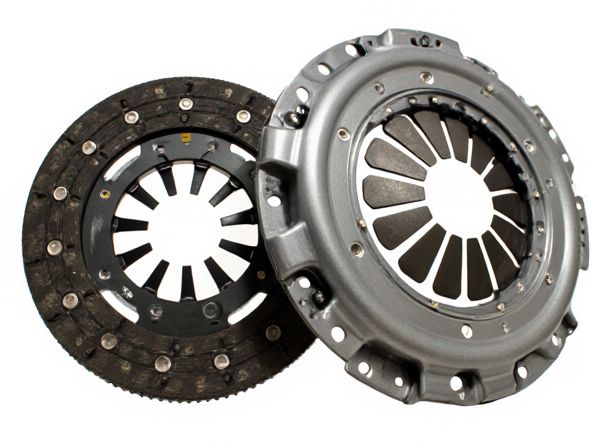
Photo illustration: Solid Center Clutch vs Sprung Center Clutch
A solid center clutch offers a direct, rigid connection for power transmission, maximizing drivetrain efficiency and responsiveness. Sprung center clutches incorporate springs to absorb shocks and vibrations, providing smoother engagement and reducing driveline shock. Choosing the right clutch depends on your vehicle's performance needs and driving conditions.
Table of Comparison
| Feature | Solid Center Clutch | Sprung Center Clutch |
|---|---|---|
| Center Hub Type | Solid hub, rigid connection | Hub with springs, flexible connection |
| Vibration Dampening | Minimal, direct engagement | Effective dampening via springs |
| Shock Absorption | Low, higher drivetrain stress | High, reduces shock load |
| Durability | High, simple design | Moderate, springs wear over time |
| Pedal Feel | Stiff, direct feedback | Smoother, more forgiving |
| Typical Use Case | Performance cars, racing | Street driving, daily use |
| Cost | Lower price point | Higher due to complexity |
Introduction to Clutch Mechanisms
Solid center clutches provide a direct, rigid connection between clutch plates, maximizing power transfer and minimizing slippage in high-performance applications. Sprung center clutches incorporate springs to absorb shock and vibrations, enhancing engagement smoothness and reducing drivetrain stress. Both designs play a critical role in transmitting engine torque to the transmission efficiently while balancing performance and durability requirements.
What is a Solid Center Clutch?
A Solid Center Clutch features a rigid hub design that directly connects the clutch assembly to the transmission shaft, providing a consistent and immediate power transfer without any cushioning or damping. This type of clutch is commonly used in performance vehicles and racing applications where precise and quick engagement is critical for maximum power delivery. Unlike a Sprung Center Clutch, it lacks springs or dampers, resulting in a more aggressive response but with increased drivetrain noise and potentially reduced smoothness in everyday driving.
Understanding Sprung Center Clutches
Sprung center clutches feature integrated springs around the clutch plates, providing smoother engagement and enhanced vibration absorption compared to solid center clutches. This design reduces shock loads on the drivetrain, improving torque transfer and overall riding comfort in varying conditions. Popular in off-road and motocross applications, sprung center clutches balance performance and durability by minimizing slippage while protecting internal components.
Key Differences Between Solid and Sprung Center Clutches
Solid center clutches provide a direct, rigid connection ideal for high-performance applications requiring instant power transfer, resulting in minimal clutch slip and increased responsiveness. Sprung center clutches incorporate springs between the plates to absorb shock and reduce drivetrain noise, enhancing smoothness and durability during engagement. The key differences lie in their design: solid centers prioritize maximum power delivery and precision, while sprung centers emphasize vibration dampening and extended component life.
Performance Comparison: Solid vs Sprung Center
Solid center clutches deliver superior power transfer and immediate engagement, optimizing performance for high-torque applications and aggressive driving styles. Sprung center clutches absorb shocks and vibrations, enhancing drivetrain smoothness and improving durability but potentially sacrificing some responsiveness. Choosing between solid and sprung centers depends on the balance between aggressive power delivery and smooth operational control in performance settings.
Durability and Longevity Considerations
Solid center clutches offer superior durability due to their rigid construction, which minimizes wear and tear in high-stress applications, making them ideal for heavy-duty performance vehicles. Sprung center clutches incorporate springs that absorb shock and reduce drivetrain vibrations, potentially extending component life but may experience faster wear under extreme conditions. Choosing between the two depends on balancing the solid clutch's long-term robustness with the sprung clutch's vibration dampening benefits to optimize longevity based on specific driving demands.
Vibration and Noise: Which Clutch Wins?
Solid center clutches generally provide a direct, rigid connection that minimizes slippage and delivers consistent power transfer but can increase vibration and noise due to the lack of damping. Sprung center clutches incorporate dampening springs that absorb and reduce vibrations, resulting in quieter operation and smoother engagement, which enhances rider comfort. When prioritizing vibration reduction and noise control, sprung center clutches are preferred for their superior ability to minimize harsh feedback during acceleration and gear transitions.
Applications: Ideal Uses for Each Clutch Type
Solid center clutches excel in high-performance applications such as drag racing and off-road vehicles, where immediate power transfer and minimal clutch slip are critical. Sprung center clutches are ideal for street and daily driving scenarios, providing smoother engagement and absorbing drivetrain shock to enhance ride comfort. Selecting the appropriate clutch depends on balancing performance demands and ride quality to match specific vehicle use.
Maintenance and Cost Factors
Solid Center Clutches require less frequent maintenance due to their simpler design, resulting in lower long-term upkeep costs. Sprung Center Clutches, while offering smoother engagement and less wear on drivetrain components, often demand regular inspection and spring replacement, increasing maintenance expenses. Initial purchase prices for Solid Center Clutches are generally lower, but total cost of ownership may rise with wear-related repairs, whereas Sprung Center Clutches have higher upfront costs compensated by better durability under variable loads.
Choosing the Right Clutch for Your Vehicle
Selecting the right clutch for your vehicle depends on driving style and performance needs, with solid center clutches offering direct power transfer suited for high-performance applications requiring quick throttle response. Sprung center clutches provide smoother engagement and vibration damping, making them ideal for daily driving and extended clutch life. Consider vehicle usage and driving conditions to balance responsiveness and comfort when choosing between solid and sprung center clutches.
 caratoz.com
caratoz.com